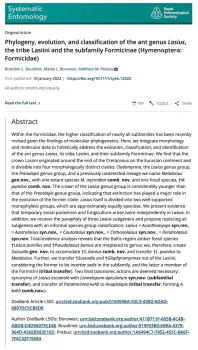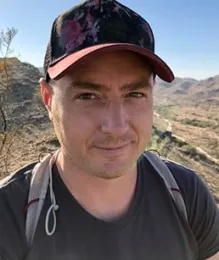Ant Research: The Story Behind the Lasius Work by Three Alumni of the Phil Ward Lab

The ant world on Twitter is crawling with congratulatory comments and how "awesome" the work is. Wrote one: "Congratulations! Lasius is a familiar genus in Japan, so I will let the Japanese entomologists know about it."
The story behind the story? It all began in the Ward lab. "The Three Ant Men" are now scattered from Idaho to Arizona to Germany.
- Borowiec, who received his doctorate at UC Davis in 2016, is an assistant professor at the University of Idaho.
- Prebus, who received his doctorate at UC Davis in 2018, is a postdoctoral scholar at Arizona State University.
- Boudinot, who received his doctorate at UC Davis in 2020, is in Jena, Germany on a two-year Alexander von Humboldt Research Fellowship to research evolutionary and comparative anatomy.
"Within the Formicidae, the higher classification of nearly all subfamilies has been recently revised given the findings of molecular phylogenetics," the co-authors wrote in their abstract. "Here, we integrate morphology and molecular data to holistically address the evolution, classification, and identification of the ant genus Lasius, its tribe Lasiini, and their subfamily Formicinae. We find that the crown Lasiini originated around the end of the Cretaceous on the Eurasian continent and is divisible into four morphologically distinct clades: Cladomyrma, the Lasius genus group, the Prenolepis genus group, and a previously undetected lineage we name Metalasius gen.nov., with one extant species M. myrmidon comb. nov. and one fossil species, †M. pumilus comb. nov. " (See more.)



Looking back, Prebus and Borowiec said that they were both interested in Lasius atopus "due to its strange morphology and lack of phylogenetic data despite the amount of attention paid to the genus, and planned a collecting trip to the type locality in Mendocino County in 2013."
The collecting trip to Mendocino proved unsuccessful. "But because of Phil's extensive collections. we knew of a population of a closely related species in Gates Canyon near the city of Vacaville," Prebus said. This time the trio collected specimens from several colonies at Gates Canyon, which is located off Pleasants Valley Road.
"For all of us, this was a collaborative side project, so after the study was presented, submitted, and rejected, it took the back-burner while people finished their dissertations, got jobs, got married, had kids, and so on," Prebus recalled. "Speaking personally, the pandemic put quite a few of my postdoc projects on hold after the Arizona State University campus closed, but the small upside amongst the inundation of downsides was that I was able to focus on getting some long-haul projects into shape for publication, including the Lasius study. This involved a huge amount of reanalysis of data that we had already collected, but thankfully didn't require generating any new data."
"In my opinion, one of the really cool aspects of this study is the method of evaluating the placement of fossil taxa in the phylogeny of the subfamily Formicinae," Prebus shared. "Because DNA data aren't available for fossil taxa, the assignment of fossils to ranks higher than species relies on the interpretation of their morphology, and historically that interpretation has relied heavily on expert opinion--and all of the biases that said experts hold. By collecting morphological data from all extant and fossil taxa in our dataset, we were able to unite the DNA data--from extant taxa--and the morphological data--from extant and fossil species--and formalize fossil placement, and evaluate the uncertainty of those placements, in model-based analyses. I think that this study joins a growing trend in systematics in general, in which we are increasingly moving away from expert opinion toward approaches that are testable and repeatable."
Follow the myrmecologists on Twitter:
- Matthew Prebus at @mmprebus
- B. E. Boudinot at @BoudAnt1
- Marek Borowiec at @mareklborowiec
